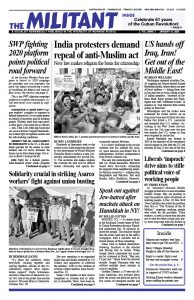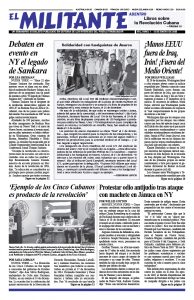In a letter below reader Briggette Blalock from San Leandro, California, asks, “What can we do about high rents?” She describes a challenge familiar to millions of workers — fighting to prevent a landlord from evicting herself and other tenants who can’t afford never-ending rent hikes. The housing crisis is a permanent feature of life under capitalism for working people.
Housing should be a basic human right available to all. And it can be. But under capitalism, the land itself and housing stock are not organized to meet these basic needs. Like everything else under this dog-eat-dog exploitative setup, housing is a commodity that is bought, sold and rented for a profit, a setup worsened by a perennial shortage and the resulting competition among workers for an affordable place to live.
Workers also face “gentrification,” as landlords and real estate speculators search for profits; blood sucking loan sharks; redlining and racist discrimination.
So in the richest capitalist country in the world more and more workers find themselves tossed on the street.
Frederick Engels, one of the founders of the communist movement, wrote in 1872, “The house owner in his capacity as a capitalist has not only the right but, by reason of competition, to a certain extent also the duty of ruthlessly making as much out of his property in house rent as he possibly can.” His booklet, The Housing Question, provides insights into how the housing racket operates under the profit system today.
Landlords squeeze us because they are driven to do so by the operation of the market system. “In such a society the housing shortage is no accident; it is a necessary institution,” Engels writes. It’s a byproduct built into the heart of capitalist exploitation.
“The pivot on which the exploitation of the worker turns is the sale of labor power to the capitalist,” he explains. Workers produce far more value for the bosses than is returned to us in wages. “It is this transaction between the capitalist and worker which produces all the surplus value which is afterwards divided in the form of ground rent, commercial profit, interest on capital, taxes etc., among the various subspecies of capitalists and their servants.”
From this understanding a way forward can be charted. One that starts with organizing together with fellow workers on the job to take back the wealth our labor produces — fighting the bosses for higher wages and giving solidarity to workers involved in struggles.
As we engage in such battles we learn to trust our own forces, develop the confidence and courage we need for the next fight against the employing class and get a true measure of our own capacities to change ourselves and our conditions.
The alternative the bosses offer workers to escape cut-throat landlords is to lure us into becoming a home “owner.” But this road offers no more respite from capitalist pillage and resulting destitution than the rents and mortgages system. It is just another way the capitalists expand the burden of debt on our shoulders and place us under the domination to yet another set of parasites. Property “ownership” chains us down with onerous mortgage payments that we spend huge chunks of our lifetimes attempting to pay off.
And the mortgage trap makes workers more vulnerable to conservative pressures, fearful we will lose what we have toiled years to claim “ownership” of, less confident to join fellow workers as they stand up to the bosses’ attacks.
As labor battles and other social struggles increase, prospects expand for building a revolutionary movement of working people. Such a movement will champion the demand for nationalization of the land and the housing stock. Take these resources that are vital for the well-being of all out of the grasp of the capitalists and place them under the control of working people.
The fight for nationalization of the land is the road for an alliance of the two producing classes — workers and working farmers, both victims of the rents and mortgages system. This is a struggle that can be won as we fight to take power out of the capitalist rulers’ hands.

